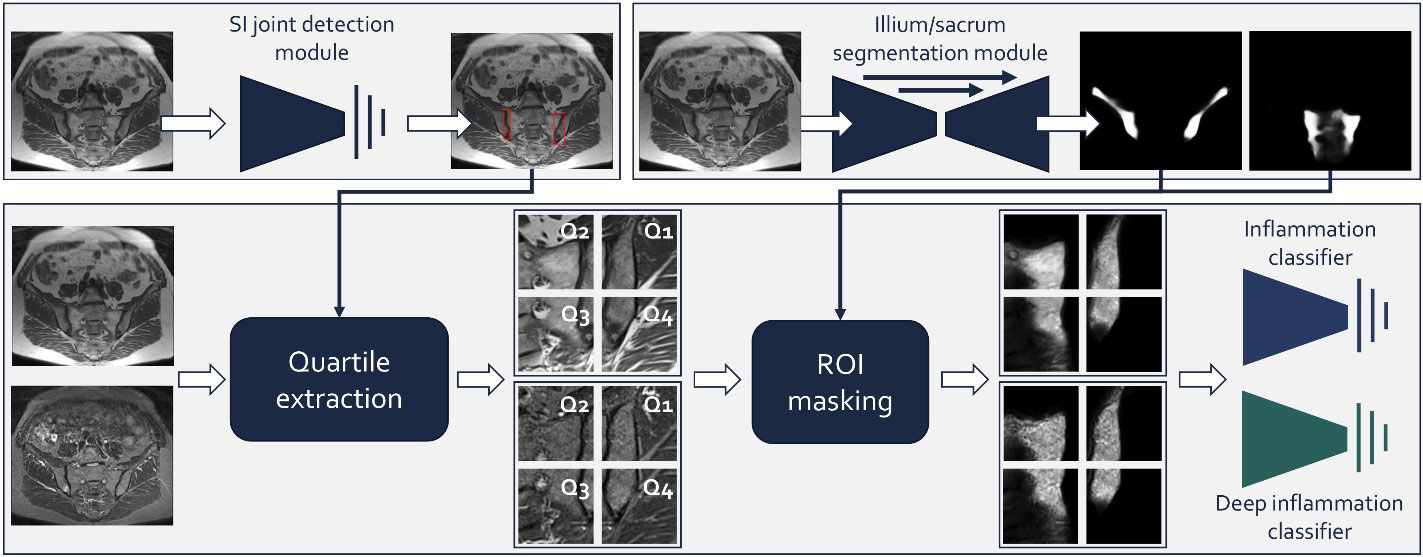Session Information
Session Type: Poster Session C
Session Time: 1:00PM-3:00PM
Background/Purpose: Detection and semi-quantitative assessment of bone marrow oedema (BMO) on magnetic resonance imaging (MRI) of the sacroiliac (SI) joints is essential for the diagnosis and follow-up of spondyloarthritis (SpA) patients. A machine learning (ML) algorithm could address intra- and inter-reader variability and the time-consuming nature of these assessments.
Methods: We developed a deep learning workflow that automatically locates the SI joints, segments regions of interest (ilium and sacrum), performs quadrant extraction and predicts presence of BMO, suggestive of inflammatory lesions, on a quadrant-level in semi-coronal slices of T1/T2 weighted MRI scans (Figure 1). Using a ResNet18 backbone, the inflammation classifier was trained and tested (5-fold cross-validation) on scans of SpA patients (n=279), postpartum women (n=71), and healthy individuals (n=114); while 243 SpA MRIs served as external validation. Patient-level predictions were derived from aggregating quadrant-level predictions, i.e. at least one positive quadrant.
Results: The proposed method automatically detects the SI joints and segments the ilium and sacrum. An area under the receiver operating characteristics curve (ROC AUC) score of 94.7%, balanced accuracy (B-ACC) of 82.2% and an F1 score of 62.1% is reported for the proposed inflammation prediction algorithm in cross validation. In the external validation dataset, ROC AUC was 88.2%, B-ACC 72.1% and F1 score 50.8%. On a patient-level, the model achieved an accuracy of 81.6% and 81.4% in the cross validation and external validation dataset, respectively.
Conclusion: We propose a fully automated ML pipeline for detection of BMO on MRI of the SI joints that has the potential to assist clinicians in early diagnosis and reliable quantification of inflammatory lesions in patients with (suspected) SpA.
To cite this abstract in AMA style:
Roels J, De Craemer A, Renson T, de Hooge M, Gevaert A, Jans L, Herregods N, Van Den Berghe T, Carron P, Van den bosch F, Saeys Y, Elewaut D. A Machine Learning Pipeline for Prediction of Bone Marrow Oedema Along the Sacroiliac Joints on Magnetic Resonance Imaging [abstract]. Arthritis Rheumatol. 2022; 74 (suppl 9). https://acrabstracts.org/abstract/a-machine-learning-pipeline-for-prediction-of-bone-marrow-oedema-along-the-sacroiliac-joints-on-magnetic-resonance-imaging/. Accessed .« Back to ACR Convergence 2022
ACR Meeting Abstracts - https://acrabstracts.org/abstract/a-machine-learning-pipeline-for-prediction-of-bone-marrow-oedema-along-the-sacroiliac-joints-on-magnetic-resonance-imaging/

